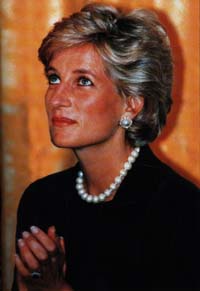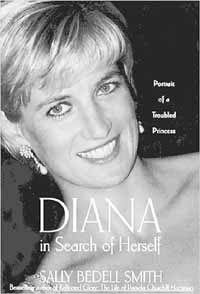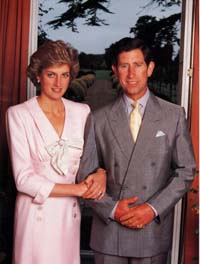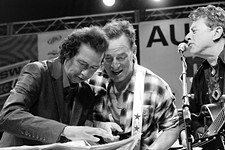The Huntress Captured by the Game
By Margaret Moser, Fri., Aug. 27, 1999
|
|
The 1999 Diana literary collection is primarily paperback versions of the hardbacks that marked the first anniversary of her death last year, but there are a couple of worthy entries in the Dianarama amongst them. There are also the stellar titles of 1998 that haven't yet made it into paper but remain definitive portraits of the princess who would never be queen.
The public appetite for Diana books seems to have wavered only slightly since the excellent Dianaby Julie Burchill (Trafalgar Square, $29.95 hard) was published last year. The ante for Diana spill-alls has gone down, presumably because Burchill seems to have the final word on the subject. Her examination of Diana's life and celebrity is done with a jaundiced eye that is merciless on Charles but also refuses to spare Diana.
Of the 110 plus books on the late Princess of Wales, only Burchill's Diana comes close to cracking the royal facade. This will come as no surprise to readers who have followed Burchill's career as a thorn in the side of British journalism. Her call-'em-as-she-sees-'em style first came into the limelight with her seminal exploration of punk in the late Seventies, The Boy Looked at Johnny. Small wonder her view of the royal family is so savage.
Burchill isn't the first to pinpoint many of Diana's problems to "the Firm" but she's the one who never lets up on the Windsors. Burchill, who coined the term "the People's Princess," assails them for treating Diana as a brood mare and their cold, unconscionable behavior after her death. And although Burchill always keeps the queen in her sights, she saves the lethal bullets for Prince Charles, repeatedly excoriating him for the "whatever love means" quote he uttered to cameras at their engagement announcement. Burchill's point is that Charles knew all too bloody well what love meant, and when he couldn't have it with his mistress Camilla Parker-Bowles, he got himself a childbearing trophy wife instead. Diana is for the true Diana-philes, the ones who accept her faults with her majesty.
Standouts from 1998 must also include Diana: Portrait of a Princessby Jayne Fincher with Judy Wade (Simon & Schuster, $35 hard). Fincher is the only female photographer among the corps of men who regularly cover the English royals beat for Newsweek, Paris Match, People, Life, and other publications. Diana caught Fincher's eye early; the first photographs in her gallery of glorious images are of Lady Diana Spencer, the rosy-cheeked, cherub-faced English Rose introduced to the world. The next images of Diana at work in her kindergarten job and herding around preschoolers suggests that Fincher was one of the dread paparazzi.
Instead, and perhaps because of her gender, Fincher befriended the princess and found a most cooperative model as well as entrée into the private side of royal life. Prince Charles called upon Fincher to take his 40th birthday portraits and those of his family as well, and the full-page photograph is rich evidence of Fincher's quite marvelous eye at the lens. The large format of the book, the fine quality of photo stock used in reproduction, and the uniform excellence of the photos make this a keeper for all royalists and well worth the hardback price.
The 1999 tell-alls are paperbacks and are harmless, inconsequential reads, revealing little new information and insight but a great deal of the authors' love for the subject. Diana: The Secret Yearsby Simone Simmons with Susan Hill (Ballantine, $6.99 paper) is a slender quickie from an "energy healer" Diana met at a London clinic. Like most authors of I-was-there books, Simmons is no writer and drafted co-writer Hill to smooth the text, but the revelations are so mild it's hard not to see dollar signs in her eyes over their friendship, especially after Diana drops Simmons socially. In fairness, though, Simmons offers a respectful and affectionate view of the Princess of Wales but it is thin, sentimental twaddle that tells few secrets.
|
|
The Diana I Knewby Mary Robertson (Harper, $5.50 paper) is equally sentimental but a bit more understandably. An American living in London, Robertson unwittingly hired the young Diana Spencer as nanny for her infant son. Faced with the question of "what do you do when you discover someone you employ has the sort of lineage and social position you've only read about?", Robertson handles the uncommon challenge with aplomb. After all, it got her invited to the wedding and the funeral. Robertson sweetly recounts Diana's metamorphosis from shy teenager to woman of the world. The Diana I Knew is a gentle, heartwarming read.
A number of books on Diana have focused unsurprisingly on her inimitable style. Dianaby Irène Frain (Vendome Press, $18.95 hard) continues the Universe of Stars series from Vendome, whose only other title features that matriarch of American royalty, Jacqueline Kennedy Onassis. Frain's Diana seems to borrow its acerbic style from Burchill's Diana but the scant 15 pages of text keep Frain's words sharp and well-chosen. It's the 60-odd photographs that make this small book of under 100 pages so captivating. Because it unabashedly admires Diana's personal style, the pictures are a glowing tribute to her celebrity and ultimately provide the most memorable images among all the new books.
In a photo taken the week before she died, Diana sits on the edge of a diving board on Dodi Fayed's yacht, an impossibly blue sky in the background. She is framed in the lower left quarter; on the upper right is a seagull, wings spread in majestic flight. Diana, tanned and in luminous good health, is not looking at the bird but over her shoulder, perhaps back at the boat, for she is dangling her long legs over the Mediterranean. Suspended over water, she is free, free as the bird flying above, free from the constraint of royal duties, free from the expectations of an adoring public, free but for the prying camera capturing that magic moment.
The Day Diana Diedby Christopher Andersen (Dell, $6.99 paper) earnestly examines the events surrounding Diana's death and the days afterward. In its first run last year in hardback, the cover featured a portrait of Diana with her two sons; clearly Andersen had curried some favor somewhere to be granted a photo of the family. That privilege was quickly yanked and replaced with a more subdued stock photo of Diana looking back, the cover that also appears in the new paperback edition.
The Day Diana Died is one of the best of the books to approach her life through her death. The detailed eyewitness account of a dying Diana at the scene of the accident is unnerving but no more so than these descriptions: Diana's body being held in an un-air-conditioned hospital room in Paris, the fighting between Prince Charles and Queen Elizabeth, or Mohammed Fayed's assertion that Diana had uttered last wishes even though a tube was placed down her throat at the crash. Andersen, a former Time editor, does his investigative research thoroughly and submits another keeper.
Althorp: The Story of an English Houseby Charles Spencer (St. Martin's Press, $24.95 hard) certainly qualifies for the Dianarama though it is not about her specifically. Reading it, however, is integral to understanding the inborn sense of noblesse oblige that came with being a Spencer, or any other English family with pedigree and a 500-year-old manor house. (To pronounce it correctly, say "Al-trupp." You know, like we say "Perdenales" for Pedernales.)
|
|
Charles Spencer, Diana's younger brother, is now the ninth Viscount of Althorp and wrote the thoroughly readable and dryly witty text. It was he who delivered his sister's eulogy at her funeral in alternately heartbroken and bitter tones. It was he who virtually damned the royal family to the whole world from the podium at Westminster Abbey. And it was he who made the arrangements for Diana to be buried on an island on the grounds of Althorp, marked with a memorial for public viewing two months of every year.
The photos are scrumptious, the antiques divine, the art breathtaking -- this family held Hans Holbein's portrait of Henry VIII until the Thirties. The exceedingly tasteful furnishings look like something out of the movies or in old English manors you only see in books. Like this one.
The winner in the 1999 Diana literary collection is Diana in Search of Herself: Portrait of a Troubled Princessby Sally Bedell Smith (Times Books, $25 hard). Burchill's Diana remains the read, but Diana in Search of Herself is no less filled with a satisfying combination of tittle-tattle and intriguing theory. Smith posits that Diana suffered from "borderline personality," as defined by her erratic behavior. This includes symptoms of unstable self-image, sharp mood swings, persistent loneliness, depression, impulsive behavior, feelings of abandonment -- in short, a litany of symptoms that seem to be quite normal considering the woman was arguably the single biggest celebrity on earth.
This is not to dismiss out of hand Smith's thesis about Diana's mental imbalance but rather to caution against the overuse of psychology to explain in florid terms those things that seem to be an integral part of the all-too-human nature. Of course Diana felt pressured by the constant pressure to perform. Of course that stress was unbelievably hard -- who wouldn't be under those circumstances? But Smith returns with compelling evidence for her diagnosis, with one of the strongest supports coming from Prince Charles, who for once is neither vilified nor homogenized. He was deeply concerned about Diana and encouraged his wife to seek treatment. Still, Smith pushes her theory of borderline personality so hard the book should be called Diana in Spite of Herself.
Smith does get some good dish going, though. One of her most notable revelations is the contingent of Diana's friends who were not convinced of the solidarity of her relationship with Dodi Fayed. They point to the way she had been devastated by the breakup of her secret romance with Pakistani surgeon Hasnat Khan just weeks before she took up with Fayed as proof it was not serious. Smith further seems to reserve her artillery for Mohammed Fayed, debunking his claim to royal lineage and the use of "al" in his name, his criminal activities, his blatant attempt to buy respectability in England, and how he relished Diana's relationship with Dodi as revenge against an aristocracy that would never accept him.
|
|
Smith also recounts Diana's less than stellar schooling humorlessly, not even stopping to snicker over the award for best guinea pig as Julie Burchill did. She goes along hither and yon, bursting like little colored balloons elaborate lies Diana told, apparently to embellish relatively dull teenage years. Unlike most every other author in the Dianarama, Smith plays no favorites between Charles and Diana. And she still manages to be engrossing about a much-analyzed subject.
No matter what, Diana seems completely worthy of adoration and admiration, if only for her ability to wear clothes like a dream, look humble before Mother Theresa, and for keeping her knees together in all those photos taken getting in and out of limos. Lord knows having a camera pointed up your skirt while sitting on a dais at a conference is enough to rattle the most composed. And for the rest of us who reveled in watching a woman flowering in her late 30s, we were robbed of the chance to see the way she would make 40. Bet she would have been stunning.
Perhaps the books are right about Diana. They ultimately say the same thing: that Diana knew how to manipulate the press and regarded it as a game. It was a game she didn't win; Diana, the huntress of Greek mythology, was captured by it.
In the end, the Windsors have possibly realized their folly in having frozen Diana out of their spotlight. They replaced her by marrying off the sexually ambiguous Prince Edward to a charming lookalike named Sophie Rhys-Jones. But Jones will never wear the crown, and Diana's 16 years as Princess of Wales will forever remain the image of royalty in the 20th century.
Senior staff writer Margaret Moser is the co-author of Rock Stars Do the Dumbest Things. She kept a 24-hour candlelight vigil during Diana's funeral, much to the amusement of her friends.












